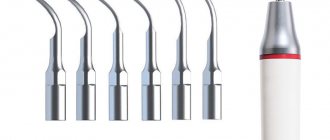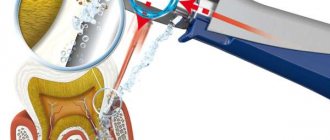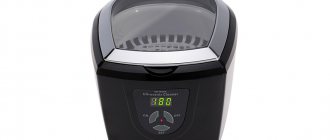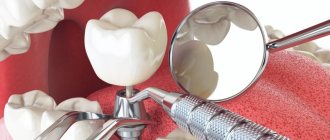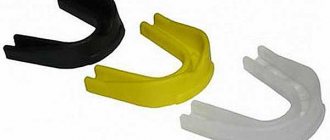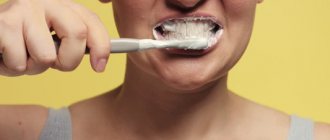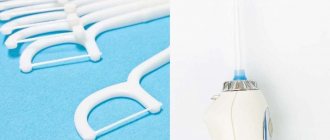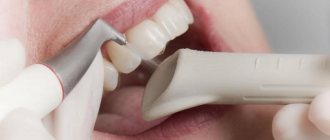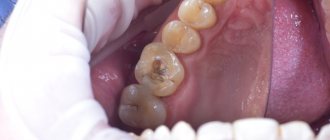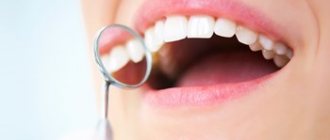The health of the dentition directly depends on the quality of care. The main prevention of oral diseases is regular cleaning. It is necessary to use toothbrushes, pastes, and floss daily. But home treatments are not enough for quality care. They do not allow you to remove hardened plaque and tartar. In modern dentistry, several methods are used to cleanse enamel. The Zuub Clinic offers its clients the safest and most effective technology.
Ultrasonic teeth cleaning allows you to qualitatively eliminate all formations, without harming the enamel, and acts as a preventive measure for major oral diseases.
What to expect during a hygiene visit?
During your initial examination and dental cleaning, our hygienist will review and evaluate your medical history to determine if there are any medical conditions that may affect your treatment.
At each subsequent visit, the Doctor will evaluate your oral health and note any changes. Each new patient visit begins with our specialists performing x-rays. If you are pregnant or have a medical condition that prevents you from having an x-ray, please note this in your medical record. If you have had an x-ray within the last 12 months, please send it to our dental clinic by email
or bring the study disc with you. Our goal is not to take an x-ray, but to have diagnostic material so that we can provide you, our patients, with a comprehensive dental examination and draw up a comprehensive treatment plan. The doctor will screen for oral cancer and oral lesions, and also test for oral symptoms of other serious diseases, including heart disease, cancer and diabetes. One of our dentists will conduct an examination of your dentition (dental examination) to look for possible new and recurring cavities. If one is found, conditions and treatment options will be explained to you. During a periodontal examination, your gums will be assessed for signs of gum disease by measuring the periodontal pockets with a probe. Our hygienists are trained and certified to administer local anesthesia to relieve discomfort during treatment, although this is rarely required as they have a very light hand and therefore a very gentle touch. As a rule, the simple use of desensitizers provides comfortable tooth brushing. At the end of your visit, the dental hygienist will teach, review, and reinforce proper oral hygiene techniques, including effective brushing and flossing. Our patients prefer to be treated by the same dentist. Regarding hygiene appointments, we support the same. Having the same professionals working with you regularly develops mutual understanding and continuity of dental care and knowledge of the individual needs of each patient.
Is it painful to have professional cleaning?
Patients often wonder if it hurts to have their teeth cleaned at the dentist. Regardless of the method used, there is no pain. A feeling of discomfort may occur when removing mineralized formations. In this case, ultrasound is prescribed. Ultrasonic teeth cleaning is also recommended during pregnancy and increased tooth sensitivity.
What does regular teeth cleaning include in our dentistry?
The teeth cleaning procedure consists of several stages:
First, the dental hygienist will identify areas of tartar and plaque. Plaque
is a soft film covering your teeth that can be removed by proper brushing, tartar or hardened plaque that can only be removed with dental instruments. The hygienist will then remove the visible deposits on the stone using our ultrasonic machine, an ultrasonic scaler that sprays water. The next part of teeth cleaning is done using hand tools called scalers. The hygienist will clean all surfaces of your teeth—even the tiny spaces between teeth and along the gum line, where plaque, tartar, and bacteria that cause gum disease collect. The last part of teeth cleaning is done using a prophylactic toothpaste. The prophylactic paste is of better quality which dissolves into a finer texture as it removes the remaining plaque from your teeth. This is the part that patients like the most because this is where the teeth become bright, shiny and smooth. While brushing your teeth, the hygienist also pays attention to areas where plaque and tartar have accumulated. These areas indicate that you need to use the best brushing and flossing techniques to maintain healthy teeth and gums between dental visits. Once your dental cleaning is complete, your hygienist will review these areas with you and provide recommendations to help you correct your brushing technique so you can maintain good oral hygiene.
How is tartar formed and why is it dangerous?
The formation of tartar occurs as a result of prolonged exposure to dental plaque, which is a residual accumulation of saliva, food microparticles, pathological microorganisms (developing in this environment) and their metabolic products.
The accumulation of pathogenic microflora is most often observed in the fissure area, the cervical area of the teeth and the gum groove area.
It only takes a few days for a dense plaque to form. This plaque is tightly attached to the enamel and cannot be removed with water. Gradually it grows, and its density increases. After a few weeks, hard tartar has already formed, provoking the development of caries and periodontal disease.
What is the cost of teeth cleaning?
We offer a package fee for examination, consultation and professional teeth cleaning in the amount of 15,000 rubles per year. If you are a healthy patient who does not require frequent dental examinations and treatment, you can pay and schedule a routine dental examination and cleaning once every six months. the cost of teeth cleaning, in the second case, will be 11,000 rubles for 2 scheduled visits. To ensure proper dental care for our patients, the first visit includes a digital oral x-ray (with panoramic x-ray), a comprehensive dental exam, nutritional counseling, oral hygiene instructions, and a dental cleaning.
Contraindications
Like any medical procedure, ultrasonic teeth cleaning has its contraindications:
- Installed pacemaker;
- Acute inflammatory processes in the periodontium, osteomyelitis;
- Oncological neoplasms in the oral cavity;
- Erosion of soft and hard tissues of the oral cavity;
- Severe form of diabetes mellitus;
- Acute and chronic infectious diseases;
- Severe diseases of the cardiovascular system;
- Epilepsy;
- A history of retinal surgery (consultation with an ophthalmologist is required).
Why are there different types of teeth cleaning?
There is only one dental procedure, which is teeth cleaning, prophylaxis or otherwise - professional oral hygiene. All other procedures, although may be referred to as cleanings, are periodontal treatments. The reason they are called “cleanings” is because the treatment process is similar to the regular teeth brushing that we are familiar with. Please read on to find out what these procedures entail.
- preventive teeth cleaning
- COMPLETE, ULTRASONIC, CALCULUS REMOVAL
- CLOSED OR OPEN CURETAGE
- CLEANING + PREVENTION OF GUM DISEASES
- This is a routine teeth cleaning performed every 6 months by a hygienist or dentist. This type of dental cleaning is provided to healthy patients to remove plaque and tartar that has accumulated above the gum line.
- This is a “pre-cleaning” procedure. It is carried out ONLY in patients with very serious stone formation, almost overgrown with teeth and gums. This procedure is performed prior to the examination and may require additional teeth cleaning and/or periodontal treatment.
is a medical procedure to cleanse the space between the tooth and gum. It is prescribed to treat early stages of gum disease or as a pretreatment before surgery for patients with more severe gum disease. The procedure will be carried out by our dental hygienist or our periodontist. The goal is to reach below the gum line and remove tartar and bacteria that accumulate on or near the roots. You may also need antibiotics to kill hard-to-reach bacteria. To learn more about periodontal disease and its treatment, visit Periodontics.
is a periodontal cleaning that can be performed by a dental hygienist or periodontist. Periodontal maintenance is prescribed in lieu of preventative dental cleanings for patients with a history of any type of gum disease. Unlike regular tooth brushing, the frequency of periodic maintenance varies. Depending on the severity of the gum disease, the doctor will decide whether the patient should undergo treatment every 3 or 4 months.
Can I have my teeth with braces cleaned at Dial-Dent if I am undergoing treatment in another clinic?
We accept all patients, no matter whether they undergo orthodontic treatment at Dial-Dent, in another clinic, or with a private specialist. Teeth should be clean and healthy! It's the most important!
There are advantages for patients of the Dial-Dent orthodontic department.
- You can combine a visit to the orthodontist (scheduled visit) and professional dental hygiene without wasting time visiting different clinics.
- If there is severe plaque buildup, the orthodontist may remove the wire from the bracket system before cleaning. After dental hygiene, the arch is installed in place. Since cleaning does not last long, orthodontic treatment is not interrupted. Removing the wires allows you to better clean all elements of the braces system, as well as the teeth around the braces and along the gums.
In any case, the teeth will be cleaned to the highest possible quality, just the time spent on brushing will differ.
Why do I need to have an examination and x-ray at my first visit?
Being one of the best dentistry in Krasnodar with more than 14 years of experience, Smile Clinic has developed its own principles to provide the best dental care to our patients. From the moment you enter our dental office, we take responsibility for your well-being. However, without x-ray vision, neither our hygienists nor our doctors can guarantee the health of your teeth. An old filling that appears healthy may have internal decay that cannot always be detected just by looking at the tooth. Periapical pathology that forms at the tip of a tooth root that may have been injured during a catch (or other contact game) cannot be diagnosed and will not be discovered until the nerve is dead, in which case you may end up root canal treatment or, even worse, removal of such a tooth.
How to prevent tooth decay?
Avoid improvised means
If you don’t have a brush or toothpick at hand, you shouldn’t try to remove a stuck piece of meat with a straightened paper clip or needle. This is dangerous both for the braces system and for your own health. You can use special dental floss. When wearing a non-removable structure, its tip can be placed under the arch. Such cleaning requires care, otherwise you can tear the arc out of the grooves.
This is how you floss your teeth if you have braces.
Teeth cleaning in Krasnodar
Brushing with a toothbrush
Use a soft-bristled toothbrush to avoid scratching your teeth.
Use a small brush head. This will give you better access even to your back teeth. Once the bristles wear out, replace the toothbrush with a new one. Use a small amount of toothpaste, that's all you need. Having more toothpaste does not mean you will brush your teeth better, but a good toothbrush will. When brushing your teeth, hold the toothbrush at a 45-degree angle and move it in a progressive motion from gum to tooth, taking your time, covering all the areas between the teeth and the surface of each tooth. A good brush lasts two minutes. Also brush the inside and chewing surfaces of all your front and back teeth. Clean your tongue and the top of your mouth before gargling. Don't swallow toothpaste. Rinse your mouth thoroughly with water after brushing. For optimal oral hygiene, it is important to floss your teeth thoroughly and daily. Due to limited space or crowding, a toothbrush may not be able to clean all the food particles stuck between the teeth. Therefore, flossing is an important step in home care. Dental floss is used to reach below the gum line and clean between the teeth. It is very important! Remove a small amount of dental floss from the dispenser. Wrap the ends of the thread tightly around your second fingers (index fingers). Guide the floss between each tooth from the top to the gum line, pulling out any food or plaque trapped between the teeth. If you have dental restorations such as crowns, veneers or bridges, pull the floss upward while moving the floss away and towards you. Remember this: we brush our teeth in the morning for others, and before bed for ourselves!
Comprehensive hygienic cleaning
For more effective cleaning of the dental surface, we recommend that our patients undergo comprehensive oral cleaning, which includes:
- Ultrasonic cleaning of teeth from tartar;
- Air Flow cleaning – removal of micro-roughness remaining on the enamel surface after removing tartar. Cleaning is carried out with a special abrasive mixture, which is supplied under high pressure. Also, with the help of Air Flow, pigment spots and “smoker’s plaque” are removed, the tooth surface becomes much lighter;
- Polishing the enamel surface with paste;
- Deep fluoridation of tooth enamel (if necessary).
If the patient, after comprehensive hygienic cleaning of the oral cavity, follows the rules for caring for the oral cavity, then he reduces the likelihood of re-formation of tartar, because prevents the hardening of soft dental deposits that inevitably accumulate on the surface of the teeth. Therefore, during the next preventive examination, teeth cleaning may be limited to using the Air Flow method to remove stained plaque.
For periodontal pockets deeper than 5 mm, it is recommended to undergo a procedure for removing hard deposits using a vector device.
